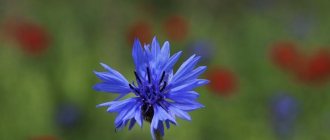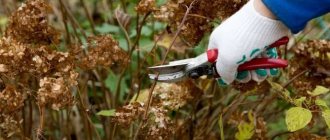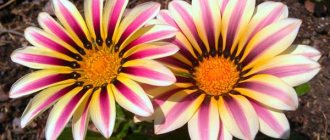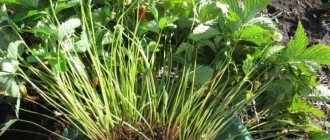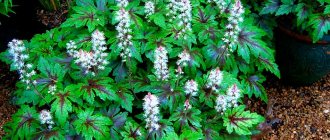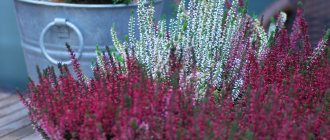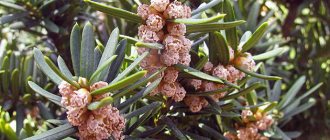In this material, we have collected everything a novice gardener needs to know about heathers, from the rules and timing of planting to the selection of beautiful varieties and the creation of spectacular flower arrangements.
Heather is an excellent honey plant that bees love. And this fact alone can be considered a strong argument to plant this flower in your garden. But this is far from his only advantage.
This plant is resistant to drought, heat and frost. It does not require complex care and hardly gets sick. In addition, heather reproduces easily. Not to mention that he is very handsome. There is something romantic and touching about this flowering bush.
If you decide to create a heather meadow in your garden, but don’t know which way to approach this matter, our article will come to your aid.
Features of heather
The heather plant branches strongly and spreads like a small shrub. Height is approximately 0.3-0.7 meters. This is an evergreen plant. The leaf plates have three sides and seem to be rolled into a tube. The flowers emit a strong aroma, although they are small in size. The shape resembles lilac-pink bells. Heather blooms in the second half of summer. But the plant becomes more beautiful as soon as the first frosts hit. Because of them, the color of the leaves changes to burgundy or yellow. This plant also serves for food purposes. It produces excellent heather honey, which is considered to be the healthiest among others.
Common heather
Botanical description
The heather plant is a strongly branching, creeping evergreen shrub from 30 to 70 cm high with small triangular leaves, as if rolled into a tube, and small, fragrant, bell-like pink-purple flowers collected in one-sided brushes. Heather blooms in mid-summer, and reaches the peak of its beauty after the first frost, when its leaves acquire yellow and burgundy shades.
Heather was glorified in Robert Louis Stevenson's ballad “Heather Honey,” which we have known since childhood. And let someone think that the story described in poetry is fiction, but the fact that heather is an excellent honey plant, and the honey from it surpasses any other honey in healing qualities, is the true truth. Landscape designers prefer to plant heather along garden paths, on alpine hills, in borders, against the backdrop of dwarf conifers.
- Yaskolka: growing and care in the garden
Sowing seeds
When deciding to add heather to your homestead, you need to remember that this is a fairly long process that will require a lot of work and effort. The advantage is the high percentage of seed germination, namely 90%. The bowl is filled with a mixture of earth, after which it is watered with a little water to moisten it. The mixture includes sand, coniferous soil and peat in a ratio of 1:1:2. The seeds are laid out on the surface of the soil, but do not go deep inside. The vessel is covered with glass and placed in a warm place (about 20 degrees C). During the first week, seedlings especially need watering. As a rule, the first sprouts will appear within 4 weeks and you should immediately begin to harden them. To achieve this, the glass needs to be opened slightly from time to time. When the sprouts expand more strongly, we move on to picking. To do this, each of them is distributed into personal pots or containers.
Planting heather
Seedling care
When summer comes, throughout its entire season, the seedlings are transferred to the garden in a semi-dark area and watered regularly. When it gets cold outside, the heather is taken into a room with a moderately cold temperature. This is approximately 11 degrees C. Only when the plant is 2 years old can it be safely planted as an independent plant. Unfortunately, in planting flowers from seed, the properties of motherhood are lost. But there is another side to the coin. As a result of your efforts, a new variety may be born that the world has not seen before.
Frequently asked questions and answers
Gardeners who are just starting to grow heather find it difficult to cope with. It is necessary to know how and what to do at each stage of its growth, as well as other cultural features.
When does the plant bloom?
Heather flowering time is the end of August. Its great advantage is that even after the flowering period, the inflorescences do not fall off, but remain on the bush, so that the latter does not lose its decorative qualities for a very long time.
What to do after flowering?
At home, heather is often grown as an annual plant. In order for the bush to safely survive the winter and delight you with flowering again next year, appropriate feeding after flowering is necessary, as well as pruning. It is also important to keep the temperature low during the winter months.
What is the lifespan of a plant?
In the garden, heather can bloom for a long time - up to 5 years, while in nature its life is sometimes calculated in decades. But at home, this period is much shorter - 1 or even 2 years, if all the necessary conditions are created.
Why does heather dry out?
The heather dries out from lack of moisture. In dry seasons, you need to provide abundant watering, do not forget to also spray the plant, and humidify the air if possible. Also, the reason may lie in the soil, which has become slightly acidic. This requires appropriate feeding; for example, you can add acid along with water twice a year.
Despite the difficulties in planting and growing, heather remains one of the most interesting and useful plants. In addition to beautiful flowers that can be admired for a very long time, it is also used in medicine and cosmetology, and therefore is highly valued by gardeners.
Planting heather in open ground
So, we looked at how heather grows. We move on to an equally difficult stage of work. Remember that it is difficult for heather to get used to a new place. So it is not advisable to replant an entire shrub. Reproduction is carried out using several methods:
- Root taps
- Seedlings
- Rooting cuttings located at the top.
- Dividing the root system.
Planting heather in open ground
The following varieties of heather are suitable for open ground:
- Alba Plena - its height is 0.2-0.4 meters. Has double flowers. It is resistant to winter, but when young, it is better to cover it with a dry leaf.
- Annemarie - 0.4-0.5 meters tall. Crown width 0.6 meters. The color of the shaggy buds is purple-red, the late flowers are dark pink.
- Carmen - 0.3-0.4 meters tall. The crown is 0.4-0.5 meters wide, its shape resembles an oval or a ball. The flowers are ordinary, pink with a purple tint.
- Dark Star - height 0.2-0.3 meters. It blooms luxuriantly with semi-double red flowers with a ruby tint for one month - September.
The best varieties for growing at home
Not many varieties of heather are used for growing at home.
Slim
One of the most beautiful indoor varieties. Neat bushes, up to 40 centimeters high, with light green leaves, densely hung with inflorescences during the flowering period. The color of the flowers is pink, red, purple, which makes them look like pomegranate clusters.
Wintering
This variety grows up to half a meter, the flowers are also larger than those of slender heather. The flowers are white, size up to 2 centimeters.
Mix
Heather mix is loved by many gardeners due to the fact that its flowers are painted in a variety of bright shades. It can be pink, purple, white. This variety reaches a height of half a meter and grows very luxuriantly. Blooms in July.
Ordinary
The height of common heather is more than half a meter, it also branches heavily, the color of the stems is reddish. Flowers of lilac and pink shades do not fall off for a long time even after the end of the flowering period.
Where and at what time is disembarkation carried out?
Gardeners with decent experience advise planting heather either in the spring (late April - early May) or in the fall (late September - early October). It is better to choose a place where you will plant the sprout that is well illuminated by sunlight. However, it can be a little shady, but always protected from strong winds. The most suitable soil option would be peaty or sandy, but dry. Limestone rock is strictly contraindicated.
If there are very few nutrients in the soil, there is nothing wrong with that. But the pH should be at least 4.5-5.5. The most suitable soil mixture is: sand, peat, tree bark compost in a ratio of 1:3:2. In order to acidify the soil a little, a layer of red high-moor peat is added on top.
How to plant
The number of seedlings distributed over one square meter of land depends on the variety you choose. Usually there are from 6 to 10. The bush is inserted to a depth of 0.25-0.35 meters. But we leave the root collar level with the surface of the earth. If the soil is clayey, then at the planting site it is necessary to organize a drainage layer 5-10 centimeters high. It can be sandy or made from pieces of bricks. In addition to this layer, add about 40 grams of horn flour and 25 grams of nitrophoska. One bush requires 5-6 liters of water during watering, which should be done immediately after planting. The top layer of soil is laid out with coniferous wood or peat. We remind you that heather does not like being replanted. Therefore, for such work, you need to immediately select a suitable place for transplantation and then take responsible care of it so that you do not have to move it to another place.
Heather care
Features of care
Due to the short length of the root system, it is necessary to maintain regular watering (every 10-15 days). If systematic precipitation is not observed, then the water for irrigation should be acidified. The soil surface must be kept moist at all times. Because of this, it is necessary to distribute a layer of mulch on it, which also protects the earth from the strong effects of the sun. After watering, the soil must be loosened through mulch to a depth of 10-15 centimeters and weeds removed. In summer, during extreme heat, the plant may suffer due to excessively dry air, so it is recommended to spray it with water every day in the evening. Fertilizer with minerals is applied annually in the spring. For one bush, feeding 1.5-2 large spoons is calculated. Dry fertilizer is scattered over the area, but it is important to ensure that it does not get on the leaves or flowers. Otherwise there will be a burn. Then the fertilizer is incorporated into the mulch and the soil is well watered. Also, pruning is carried out annually in the spring to shape the plant and stimulate the growth of new shoots. Heavy pruning is allowed only after 3 years of heather planting. There are certain rules for cutting hair:
- The left hand holds the inflorescences by the upper part
- The right one cuts off half or 2/3 of the inflorescence.
- The cut parts can be used for fertilizer. To do this, cut them finely and sprinkle mulch on top.
Necessary conditions for a flower
Heather lives shorter in an apartment than in the wild or garden - up to two years. In order for the plant to delight with flowers all this time, it is necessary to grow it correctly and then care for it.
Place and lighting
When choosing a room in which you plan to grow heather, you need to consider the following:
- it should be well ventilated;
- Heat harms the plant, so you need to prevent overheating (do not place it near heaters or radiators);
- a lot of diffused sunlight.
The ideal option is an insulated loggia, where the desired temperature will be maintained in winter. But avoid the south side and direct sunlight.
Temperature
High temperatures are detrimental to heather. Therefore, in winter it is enough for him to have +12-15 degrees, in summer – up to +25. When growing seedlings, try to keep the temperature around +18-20. Stuffiness is also contraindicated for the plant. But temporary removal to the street in spring and autumn on warm (but not hot!) days will have a good effect.
Indoor humidity
An abundance of moisture is important for heather; it will not grow well in rooms with dry air. To avoid this, gardeners advise spraying the bushes.
Optimal soil composition and pot volume
For heather, a shallow and wide pot is best, but when planting the plant you need to focus on the roots. The depth of the container should exceed their length, and as the heather grows, it needs to be transplanted into a larger pot. Often heather is planted in long boxes, then you can put together a composition of several varieties.
As for the soil, the best option is acidic soil with a base of peat and humus, which will contain a sufficient amount of organic matter. Good drainage is also important.
Pests and diseases
The positive side of heather is its resistance to insects and pests. But there are things that can come under the influence of fungal diseases. Most often, heather thickets suffer from gray rot. The cause of this disease may be low soil permeability. In winter, snow can melt quickly, which also causes too much water in the root system. When a shrub of the heather family becomes ill in this way, a white coating appears on its stems and gradually they and the leaves die off. To overcome such damage, fungicidal agents are used. Topaz and Fundazol are recognized as the most successful in this matter. If the case is advanced, use a 1% solution of vitriol. Heather is treated with it three times every 5-10 days. For preventive purposes, in the spring, the heather bush is treated with fungicides immediately after the cover is removed and in the fall during preparation for the winter period.
Another type of disease is powdery mildew. Because of it, new shoots wither, and the leaves become covered with a white coating of a loose consistency. The plant may also become infected with rust. A sign of this are brown-red spots on the leaves. All these diseases are of fungal origin. Therefore, fungicides are also used to combat them.
Heather plants are still susceptible to viral diseases. Because of them, the flower is deformed, the color becomes uneven, completely different from this plant. Unfortunately, this disease is incurable. All affected plants will have to be removed from the ground and destroyed. To avoid the spread of the disease, the soil must be treated with potassium manganese. It is better to take a strong solution.
Powdery mildew on heather
However, if the soil was selected correctly during planting and the heather bush received the necessary care, it will not get sick.
Heather propagation
It was described above how to propagate heather by seeds. And point by point it was briefly said what other methods exist. Let's look at each of them in a little more detail.
- Root taps. The first step is to create a small hole in the ground. A branch is selected that is suitable for such planting and is freed from leaves, except for the very top ones. Next, it is bent and secured in the hole using a wire pin. The part of the branch on which the leaves remain remains above the ground and is carefully tied to the support. Then the hole is watered and the area is covered with soil. Once the branch has taken root, it can be cut back from the original bush to live on its own. And after a year, transplant it to a new place.
- Saplings. Those seedlings that have taken root are recommended to be replanted in the spring. However, this work can be carried out in the fall. It is best to buy them ready-made in containers in stores specialized in this topic. As a rule, with such a purchase the roots are collected together. Therefore, during planting, they need to be separated and carefully directed in the right direction. If you skip this stage, then in the near future the plant will simply die. First, dig a hole of small depth, but wide in size. Water is poured there, the seedling is placed and buried with soil to the level of the root collar. Then the soil is compacted with hands and watered again. The next step will be covering the soil around the seedling with sawdust or wood chips. Some people do it with peat. To avoid high humidity when the soil is clayey, drainage is done. To achieve this, before planting, a layer of 2-3 cm of pebbles, bricks or crushed stone is poured into the hole.
Planting and caring for heather
- Rooting cuttings. The branches are prepared at the end of August by cutting off the woody ones from the plant. But you need to choose ones that do not have flowering elements. Separately, a mixture is prepared in a vessel: peat and sand in a ratio of 2:1. The cuttings are planted in this soil and watered moderately. The soil needs to be fertilized with microelements and urea twice a month. The most suitable temperature to store cuttings is considered to be no more than 18 degrees C.
- Dividing the root system. It is also better to do this work at the end of August. To begin with, the entire bush is carefully removed from the ground. Those stems that have already died must be removed and the root divided into several parts. At this stage, it is necessary to ensure that there are new shoots on each of these parts. Each of the separated parts is planted separately in the ground and watered abundantly. Then a layer of sawdust, peat or pine chips is spread around them.
Heather after flowering
We looked at how heather propagates by seeds and other methods. But it is important to know how it behaves in extreme weather conditions. In areas where the climate is warm, heather flowers survive the winter calmly and do not need to be covered. But, if it is very cold on your territory in winter, the heather bush must be prepared for overwintering. When frost sets in, the soil should be covered with a layer of peat, and the plant itself should be covered with spruce branches. It will protect the heather from cold and hot rays in the spring. This coating can only be removed in April.
Heather after flowering
Heather seeds: collection and storage
One way to propagate this plant is to collect and plant its seeds. Heather seeds are formed in its inflorescences, similar to small boxes, and reach a very small size - about one millimeter. Collecting heather seeds is not difficult, however, for its successful implementation, you need to know some nuances.
In order to have time to collect heather seeds, you need to know the period of its flowering, in particular, when it ends. In most cases, heather begins to bloom in July. And the seed boxes ripen around the end of August - beginning of September, on average within two weeks after the plant has flowered. In order not to miss this moment, it is advisable not to rely on dry statistics, but sometimes check the condition of the flower boxes. The main sign by which you can understand that the seeds are ready is the color: a ripe flower box will be painted in shades of straw color.
Ripe heather seeds must be collected in dry weather, without waiting for the onset of the rainy season and high humidity. Otherwise, wet flower boxes and the seeds in them may rot and deteriorate during the drying process.
The most universal and simplest way to collect ripened seeds is to collect the seeds in a bag. To do this, you need to take a paper bag and put it on a branch with inflorescences that you like. Then tie the bag tightly with the branch inside and disconnect it. Next, the bag with the cut branch needs to be turned over and shaken for several minutes. So the bag can be hung for seed ripening: during the process, the ripened seeds will fall off, and you will only need to indicate on it the name of the seeds and the date of their collection.
Collecting heather seeds is not that difficult. Every person is able to do this. So that your efforts are not in vain and the seeds do not spoil, you need to know how to store them correctly.
After collecting heather seeds, they are left to ripen or dried in a place with good ventilation, without access to sunlight. During the drying period, the seeds should be left on a paper sheet or a dry plate. “Ready” heather seeds, for storage, must be poured into paper or fabric bags and stored in a dark, dry place, with a temperature of 15 to 20 C. In such conditions, heather seeds can retain their properties for a long time, and still not get confused , indicate the date of collection on the package.
Main types and varieties with photos and names
It is impossible to list all varieties of heather. Below is a summary of some types of heather.
- Garden heather. A variety that is resistant to frost and is distinguished by its height. Its leaves and flowers have a unique color. There are several categories of it: high, medium and short.
- Heather boskoop. They are striking in their color scheme, which changes depending on the time of year. In summer - golden leaves with a yellow tint. In winter and autumn - orange with a copper tint.
- Wild heather. You can meet it on the territory of Russia, located in Europe, in the Urals. It is also located in the Siberian region in the western and eastern parts. Likes to live in forests where there are many pine trees. Selects sandy, dry areas and even near roads.
- Tree heather. Its height is amazing. It can grow up to five meters. This is an evergreen plant. The leaves are bluish in the shape of needles 1 centimeter long. The flowers are white. It emits a rather pleasant aroma.
- Marsh heather. The leaves are miniature, lanceolate. Has a strong honey smell. One hectare of plant can produce 200 kg of honey.
- Heather Evergreen 50 cm handsome. Leaves with scales. From August to November it pleases the eye with its red and crimson flowers, which also smell pleasant.
Unique honey plant
Having supplemented the botanical name of the crop with the modest adjective ordinary, people have never ceased to love it and treat these hardy flowers with great respect. They said about him that where the heather settled, a person could survive. It was especially valued by beekeepers as the latest honey plant, producing nectar at the end of summer and even in autumn. This late bribe was poetically compared by the people to a belated last love. Nobody is indifferent to this famous honey - either they completely reject it for its tart and characteristically bitter taste, or they fall in love with it for life. Moreover, the bees themselves, which produce 200 or more kg of honey from each hectare of heath, are more likely to be among the former and assimilate it difficultly, so usually in winter the honey is pumped out completely, replacing it with another for winter bee feeding. It has a special yellowish-red color, a strong aroma, gives a slow, fine-crystalline sedimentation and has unique medicinal properties.
Using heathlands for grazing sheep, residents of the gray regions of Germany managed to breed a special breed of them, the distinctive feature of which is extraordinary endurance and the ability to feed on this unusual pasture almost all year round.
Useful properties of heather
In addition to its aesthetic properties, this plant also has medicinal elements. It is used in folk and traditional medicine due to its antibacterial, diaphoretic, expectorant, diuretic and cleansing properties. Here are some diseases that are cured with it:
- Cough
- Cystitis
- Kidney diseases
- Urethritis
- Diarrhea
- Gastritis
- Gout
- Skin diseases.
Heather honey
It contains potassium, calcium, sodium and acids of organic origin. Its decoction cures:
- Lack of sleep
- Vascular atherosclerosis
- Diseases of the gastrointestinal tract
- Cholecystitis
- Excess weight
- Inflammation in the mouth
Flower powder is used when available:
- Ulcers
- Eczema
- Wounds
- Burns
Heather infusion helps with hair loss if rubbed into the scalp. I recommend taking heather baths for radiculitis. Alcohol tincture serves as an excellent assistant during tuberculosis. Before using heather, it is better to consult a doctor, as it is contraindicated for people with high acidity of gastric juice.
In addition to treating diseases, this plant is used in:
- Pet food
- Fillings for scented pillows and for making winter bouquets.
- Seasonings for dishes
- Making heather tea

